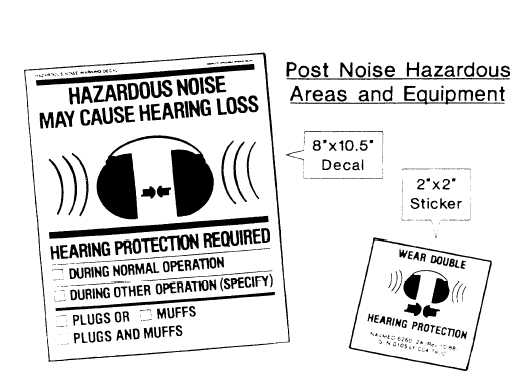| |
Figure 5-3.—Hazardous noise labels.
The person qualified to take the noise measurements
uses a sound level meter to identify all potentially
hazardous noise areas. The work areas where the sound
level, continuous or intermittent, is routinely greater
than 84 dB(A) or where the peak sound pressure level,
caused by impulse or impact noise, routinely exceeds
140 dB are considered hazardous noise areas. These
areas and equipment are then labeled to warn of the
noise hazard.
Hearing Tests/Audiograms
Hearing tests, or audiograms, are required
monitor the hearing of workers routinely exposed
hazardous noise. Periodic monitoring will allow us
catch a hearing loss before it becomes severe or
to
to
to
to
correct potential problems with hearing-protective
devices. Audiograms test a person’s hearing at a variety
of frequencies in the human speech range. Audiograms
can be conducted at most Navy clinics, aboard tenders,
and aboard air capable surface ships.
Personnel working in hazardous noise areas must be
entered in the Hearing Conservation Program. Military
personnel should have received a reference hearing test
upon entry into naval service. Civilian personnel being
considered for employment in an occupational specialty
or area that involves routine exposure to hazardous noise
should receive a reference audiogram. Navy employees
presently in service who do not have a reference
audiogram filed in their health record will not be
assigned to duty in designated hazardous noise areas
until they receive a reference hearing test. All personnel
should receive a hearing test periodically and before
ending their naval service or civilian service.
Labelling of Hazardous Noise
Areas and Equipment
Make sure you label designated noise-hazardous
areas with the approved 8-inch by 10.5-inch decal (fig.
5-3). Normally, you should apply the proper decals to
the outside of all doors or hatches leading into the
noise-hazardous area. That ensures personnel know
what protection they must wear in that area. Label
equipment, such as hand tools, with the approved
2- by 2-inch hazardous noise sticker, NAVMED
6260/2A (fig. 5-3). This sticker ensures personnel know
whether to wear single or double protection when using
that equipment.
Personal Hearing-Protective Devices
When a hazardous noise area or operation is
identified, we try to control or eliminate that noise
hazard using engineering controls. These controls
include the use of acoustic material, the isolation of
noisy equipment, or the substitution of a less noisy
process. If we cannot reduce the noise to a safe level,
then our only choice is the use of personal protective
5-8
|

